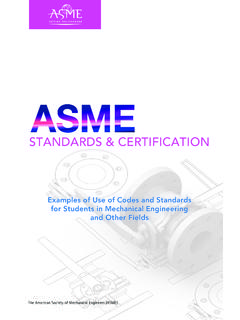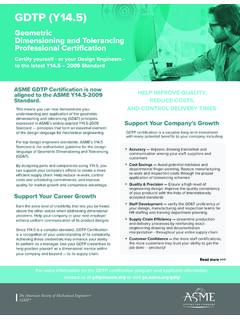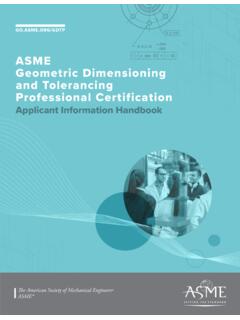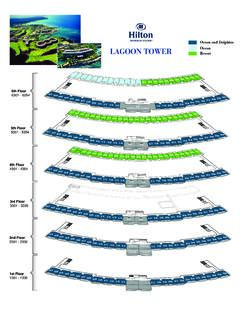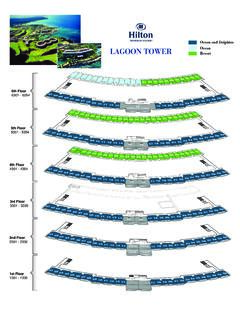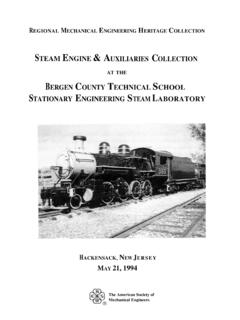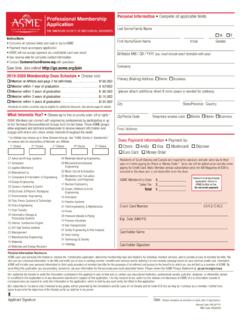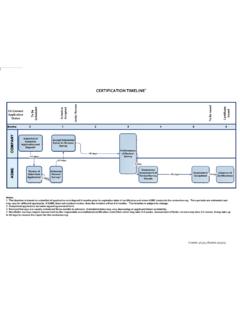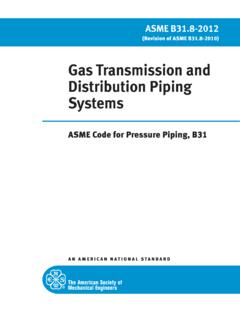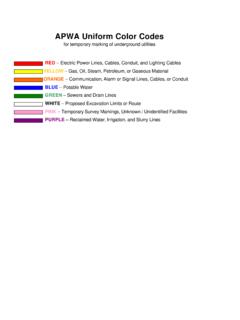Transcription of ASME
1 STANDARDS & CERTIFICATION. Examples of Use of Codes and Standards for Students in Mechanical Engineering and Other Fields The American Society of Mechanical Engineers (ASME). D E A R ENGINEE RING STUDENT: The articles in this booklet explore different facets of ASME Standards &. Certification. ASME Standards & Certification plays an important role in ensuring the safety of the public and in the standardization of things as common as nuts and bolts. We have selected the articles to draw your attention to some important aspects of your professional life and future in the mechanical or related engineering field. For an overview of ASME Standards & Certification, see the Codes and Standards at a Glance section, which immediately follows the articles. We hope that you find this collection of articles interesting and informative, and that it provides you with a new window into the field of ASME Standards and Certification.
2 Please let us know what you think at: Sincerely, Task Group on ASME Codes and Standards for Mechanical and Other Engineering Students Kenneth Balkey, , Consulting Engineer, Westinghouse Electric Company Domenic A. Canonico, , Canonico & Associates Angel Luis Guzman, Project Engineer, ASME. Pamela F. Nelson, Professor, UNAM. Mark Webster, , Vice President Engineering, Pflow Industries, Inc. Steven Weinman, Director, Standardization and Testing, ASME. This brochure is an update of the previous brochure, which was issued about a decade ago. The Task Group acknowledges the work of the previous task group of: Gerard G. Lowen, Chair; Guy A. Arlotto; Stuart Brown;. Domenic A. Canonico; Ryan L. Crane; John H. Fernandez; Philip M. Gerhart;. Halit M. Kosar; Richard Merz and Sam Zamrik. 1. ABOUT ASME. ASME Mission To serve our diverse global communities by advancing, disseminating, and applying engineering knowledge for improving the quality of life and communicating the excitement of engineering.
3 ASME Vision ASME, the American Society of Mechanical Engineers, will be the essential resource for mechanical engineers and other technical professionals throughout the world for solutions that benefit humankind. SME is a not-for-profit membership A. ASME HELPS THE GLOBAL organization that enables collaboration, knowledge sharing, career enrichment, and ENGINEERING COMMUNITY skills development across all engineering disciplines. Founded in 1880 by a small DEVELOP SOLUTIONS TO. group of leading industrialists, ASME has REAL WORLD CHALLENGES grown through the decades to include more than 120,000 members in over FACING ALL PEOPLE AND 140 countries around the globe. The membership includes a wide diversity of OUR PLANET technical disciplines who represent all facets of the technical communities. ASME's diverse members range from college students and early-career engineers to project managers, corporate executives, researchers, and academic leaders.
4 ASME serves this wide-ranging technical community through quality programs in continuing education, training and professional development, standards and certification, research, conferences and publications, government relations, and other forms of outreach. Many engineers join ASME for career enrichment, lifelong learning, and the opportunity to network with professionals of like-minded interests. Others become active in local sections or in ASME's administrative structure of boards and committees, providing leadership and expertise to the Society and the profession at large. The governance of the Society is the responsibility of member-elected governors, who volunteer their vast knowledge and expertise to the organization. The board of governors and other volunteer leaders of ASME work in collaboration with a professional staff to shape the Society's programs and strategies and make them available to engineers throughout the world.
5 ASME. administers its programs through offices and institutes in the United States, Belgium, China and India and through various committees and groups, to ensure that the myriad technical interests of its members and the global engineering community are met. More information about ASME can be obtained from 2. A S T R A T E G I C R OAD MAP GUID E S A SME. ASME strategically aligns its programs and initiatives to focus on three main organizational priorities energy, engineering workforce development, and global impact in an effort to provide relevant knowledge-based resources to the broad spectrum of ASME members and constituents. In energy, ASME is serving as an essential energy technology resource and leading advocate for balanced energy policies. In engineering workforce development, ASME fosters a broader, competent, vibrant and more diverse engineering workforce, with improved retention in both the profession and ASME over all career stages.
6 And in the area of global impact, ASME is committed to delivering locally relevant engineering resources to advance public safety and quality of life around the world. Among many examples of the Society's growing outreach in the global arena is Engineering for Change (E4C). E4C is a dynamic community of engineers, technologists, social scientists, NGOs, local governments, and community advocates whose mission is to improve people's lives in communities around the world. E4C features an open, innovative, and user-friendly online platform that facilitates collaboration and knowledge exchange for the development of appropriate solutions to issues such as sanitation, access to clean water, energy, transportation food, education and housing. More information about E4C can be obtained from 3. ASME'S ROLE IN THE GLOBALIZATION. OF CODES AND STANDARDS. by Donald R. Frikken, , Becht Engineering Company Movement to harmonization of standards requirements has taken on greater interest as companies continue to merge or expand operations across international boundaries, helped by regional trade agreements such as the North American Free Trade Agreement (NAFTA) and those established by the European Union (EU), which have facilitated international mergers through the lowering of tariffs on imports.
7 The companies involved in these consolidations or expansions are used to selling to just one market, find themselves selling to global markets. The standards for products in these markets are often different, which complicates manufacturing procedures. Local laws may require the use of a particular standard, yet these laws are viewed by the World Trade Organization (WTO) as technical barriers to trade, and WTO member countries are charged with reducing these and other barriers to free global trade. What is the best way for standards-developing organizations like ASME and for users of standards to find a solution? Possible approaches are to adopt a prevalent standard, to perform a comparison of standards requirements to identify areas of possible convergence, or to develop an umbrella standard that references other regional and national standards. On new emerging topics or technologies, a global consensus standard may possibly be developed from scratch.
8 ASME is involved in helping promote whichever approach best serves a specific industry and the users of the applicable ASME standards. ASME standards have changed over the years to include new construction materials, to address new topics, and to incorporate new calculation methods. As these changes continue to be introduced, global developments bring even more change, requiring greater flexibility and adaptation from industry. 4. ELEVATORS, ESCALATORS AND MOVING WALKWAYS. by Jim Coaker, Coaker & Company, PC. How many times in the past week have you A NORMAL ridden in an elevator, on an escalator, or on a moving walk? These actions are so routine in CONVENIENCE IN everyday life that they happen automatically EVERYDAY LIFE and are too numerous to recall. FUNCTIONING Behind each mechanism is a web of machinery, power sources, control systems, and redundant WITHOUT INCIDENT safeguards in both design and operation that delivers safe vertical transportation without incident.
9 ASME elevator and escalator standards (A17. series), consisting of safety codes for elevators and escalators (including a code that covers existing installation requirements), Inspectors'. Manuals, and Guidelines covering evacuation and electrical equipment requirements, is one of the largest areas covered by the Society's codes and standards program. Elevator ridership in the United States is conservatively estimated at more than 200 billion passenger rides per year, a figure that makes it easy to appreciate the critical role that codes and standards play in public safety. Dynamic change defines the world of technical applications and ASME's standards are constantly updated to keep abreast of changes in technology. Starting with basic design principles relating to public safety, these codes and standards establish guidelines and requirements for equipment design, installation, operation, inspection and maintenance.
10 Performance-based codes have been developed to provide guidelines and requirements to allow latest state-of-the art technology, design, and materials in engineering design of new and renovated elevator systems. Advancements in technology and updates to codes and standards that support elevator systems have led to buildings that are ever taller, more efficient, and more resistant to natural forces helping to sustain the infrastructure of many of our great cities. Even if the end result is invisible a normal convenience in everyday life functioning without incident underlying complexities of system application present stimulation and challenge to the engineering mind. Some professionals spend their careers in this industry. 5. W H A T AR E P E R FOR MAN CE TE ST C O DES? by Philip M. Gerhart, , , University of Evansville and Samuel J. Korellis, , EPRI. ASME Performance Test Codes (PTC).
